 Research Article
Research Article
3D Concrete Printing with Robot - Resulted Properties
György L Balázs1* and Marwah M Thajeel2
1Department of Construction Materials and Technologies, Budapest University of Technology and Economics, Hungary
2Department of Construction Materials and Technologies, Budapest University of Technology and Economics, Hungary
György L Balázs, Department of Construction Materials and Technologies, Budapest University of Technology and Economics, Hungary
Received Date:February 01, 2024; Published Date:March 11, 2024
Abstract
3D concrete printing has revolutionised the construction industry by enabling the production of complex geometries and customised designs. Using 3D concrete printing technology in the construction field offers numerous advantages, such as design freedom, cost efficiency, and construction speed. Due to the process of extruding the concrete layer by layer, the 3D printed object will be orthotropic. Therefore, the objective of this study is to investigate how varying water content and printing direction affect the compressive strength of cast and printed cubes. Three different water-todry material ratios (w/d) were used: 0.140 l/kg, 0.145 l/kg, and 0.150/l/kg. The printed cubes were tested in three different directions: X, Y, and Z.
The results showed that for all three mixtures, the cast cubes showed a higher compressive strength than the printed cubes. An anisotropic behavior was observed in the compressive strength of the printed cubes for all mixtures, depending on the loading direction. Mixture 0.145 l/kg showed the best compressive strength in the three directions compared to the mixture 0.140 l/kg and 0.150 l/kg.
Keywords:3D concrete printing; Additive manufacturing; Layer-by-layer, Orthotropy, Structural integrity, Water content; Loading directions; Compressive strength
Introduction
Over the past few decades, additive manufacturing, commonly known as 3D printing, has revolutionised various industries by enabling the production of complex geometries and customised designs. This technology has also made its way into the construction sector with the advent of 3D printed concrete [1,2]. It involves using specialised printers capable of creating threedimensional structures using concrete as the primary material. This innovative technique offers numerous advantages over traditional construction methods, including increased efficiency, reduced labour costs, and enhanced design flexibility. By utilising computeraided design (CAD) software, architects and engineers can create intricate designs that were once deemed impossible to achieve with conventional techniques [3,4]. Currently, two primary 3D concrete printing (3DCP) technologies are being developed: extrusion-based and selective binding methods [5]. This article primarily focuses on extrusion-based 3DCP. Several companies, including Contour Crafting, CyBe, XtreeE, WinSun, Apis Cor and others, have attempted to implement extrusion-based 3DCP in practical applications [6], highlighting the potential of this technology.
Integrating 3D concrete printing technology into the
construction field offers numerous advantages [7], such as
1. Design Freedom: 3D concrete printing technology
enables the creation of complex and intricate designs that were
previously difficult or impossible to achieve with traditional
construction methods. This freedom allows architects and
designers to explore innovative shapes, patterns, and textures
[8].
2. Cost Efficiency: By eliminating the need for formwork
and reducing labour costs by 50-80%, 3D concrete printing
technology offers significant cost savings in the construction
process [9]. Additionally, it minimizes material waste by only
using the required amount of concrete, optimising resource
utilisation [10].
3. Construction Speed: The automated nature of 3D concrete
printing technology speeds up the construction process
compared to conventional methods. It reduces project timelines
by automating repetitive tasks and streamlining workflows,
leading to faster completion times [11]. Compared to traditional
construction methods, using additive concrete manufacturing
with structural optimization has yielded a significant reduction
by around half in environmental impact [12,13]. This means
that 3D printing technology has a big impact on the construction
industry, and it is crucial to understand its possible benefits.
Orthotropy
One of the key aspects that researchers have focused on is the orthotropic behavior of 3D printed concrete. Orthotropy refers to a material’s anisotropic behavior along different axes due to its inherent microstructural characteristics. In the case of 3D printed concrete, the layer-by-layer deposition process introduces variations in material composition and microstructure that affect its mechanical properties. Studying the orthotropic behavior of 3D printed concrete allows engineers and researchers to assess its strength, stiffness, and durability under different loading conditions accurately [14]. One of the critical parameters of the 3D printed concrete mechanical characteristics is the compressive strength that determines its ability to withstand applied loads without failure. Understanding the compressive strength of 3D printed concrete is essential for ensuring structural integrity and safety in construction projects.
The compressive strength of 3D printed concrete is influenced by various factors that must be carefully considered during the fabrication process. Firstly, the mixed design plays a crucial role in determining the strength of the printed structure. The selection and proportioning of cementitious materials, aggregates, water content and additives should be optimized to achieve the desired performance. Secondly, printing process parameters such as time gap between the layers, nozzle standoff distance, nozzle diameter, printing speed, and pumping rate significantly impact the compressive strength.
Based on numerous prior investigations [15-17], increasing the time gap between layers could offer sufficient time for the static yield stress development within the deposited layers, thereby improving buildability. However, this extension may lead to a reduction in bond strength. Chen et al. [18], showed that increasing the time gap from 1 minute to 20 minutes resulted in a 13% reduction in bond strength compared to that of cast specimens. Nozzle standoff distance also has a significant effect on the mechanical properties of the 3D printed concrete. Panda et al. observed a significant decline of over 30% in bond strength as the nozzle standoff distance was increased. Increasing the nozzle standoff distance will increase the layers instability due to reducing the contacted area between the layers. Moreover, the correlation between the pumping rate and printing speed in 3D concrete printing is critical for the stability and quality of the printed layers (Figure 1). Using a high pumping rate with slow printing speed will produce layers with width much greater than the nozzle width and this could cause back pressure and stoppage. While the slow pumping rate with high printing speed will reduce the layers width than the nozzle width and that will lead the layers overlap, resulting in instability [16].
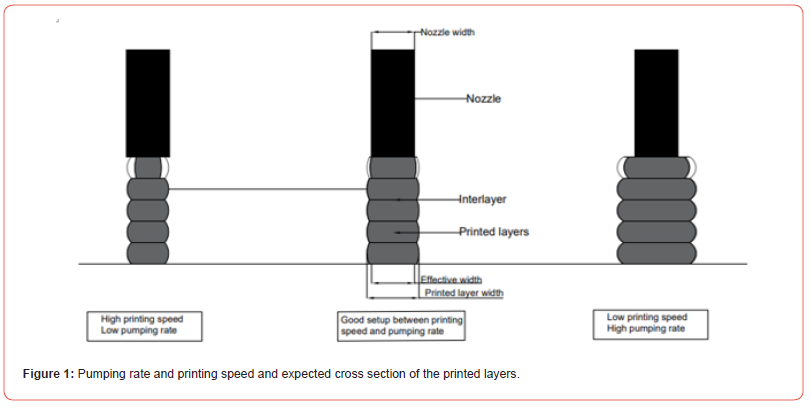
These parameters affect the interlayer adhesion and overall mechanical characteristics of the printed concrete. Furthermore, many studies investigated the effect of mix design properties such as the aggregate to binder ratio, chemical admixture, water content, nanomaterials, eco-friendly binder on the pumpability, printability, and buildability of the printed concrete [19-24]. However, to our knowledge, the effect of these parameters on compressive strength of the printed concrete is still an open research question. Hence, the objective of this paper is to investigate how varying water content and loading direction affect the compressive strength of printed cubes. For comparative analysis, cast cubes of identical dimensions to the printed ones were also tested.
Realizing the experimental program by a six-axis robot system and a mixer
Materials
A pre-mix material of Portland cement, selected aggregate and additives from Sika called Sikacrete®-751 3D was used to prepare the 3D printed and cast specimens. Sikacrete®-751 3D has a light grey-white colour with an accelerated setting suitable for cool climates with a maximum grain size of 1 mm. As a one component material, it only needs to be mixed with water, providing ease of use. It has low viscosity for easy pumping, good thixotropic consistency for good buildability and maintains shape after extrusion. More information about the material is provided by the producer [25].
3D Concrete Printing Setup including robotic printer and robotic controller
A large-scale six-axis robotic system was used to perform 3D concrete printing at the Budapest University of Technology and Economics, as shown in Figure 2a. The printing system consists of three essential parts: a mixer and conveying pump, a robotic printer and a robotic controller. The utilized robot was IRB 6700. The robot can perform printing operations with a 360-degree rotational capability, encompassing a horizontal diameter of 3 m and a vertical height of 3 m, and with extension, can reach up to 6 m. The movement of the robotic arm can be adjusted between 0 mm/s to 200 mm/s. The robotic arm is connected to a controller that governs the movement of the head of the robotic arm. The used mixing machine was MAI®MULTIMIX-3D Figure 2b, which includes three main parts: a hopper with a capacity of 45 L, motor feeder system (extruder with a barrel and a die). This mixer has its own controller to control the water content and pumping speed. The pumping speed can be adjusted between 0 L/min to 8 L/min. The pump draws the material from the feeder and conveys it to the robotic print head via a flexible hose conduit. The hose has dimensions of 25 mm in diameter and a length of 5 m.

Specimens’ preparation though the robotic head
The dry pre-mix material was mixed with three distinct waterto- dry material ratios (w/d): 0.140 L/kg, 0.145 L/kg, and 0.150 L/kg. Utilising a pump mechanism, fresh mixtures were extracted from the feeder and transported to the robotic head through a flexible hose, then extruded via a circular nozzle with a diameter of 20 mm at the robotic head. Consistency was maintained across the three mixtures regarding pumping speed, printing speed, layer width, and layer height, set at 1.5 L/min, 84 mm/s, 22 mm, and 10 mm, respectively.
Each of the three mixtures was utilised to print a 3D concrete slab measuring 580 mm × 390 mm × 110 mm (L × W × H), depicted in Figure 3. Owing to the layer-to-layer extrusion technique employed, the resulting printed slab exhibited orthotropic characteristics, leading to property variations along different directions (X, Y, and Z), as shown in Figure 3a. The X direction denotes the longitudinal path of printing, wherein the robotic nozzle operates, while the Y direction illustrates the lateral arrangement of printed layers perpendicular to the X direction. The Z direction signifies the height of the print. After completion of the printing process, the printed slabs were shielded with a plastic sheet for two days to prevent excessive drying, thereafter, stored under laboratory conditions and subjected to testing after 28 days.
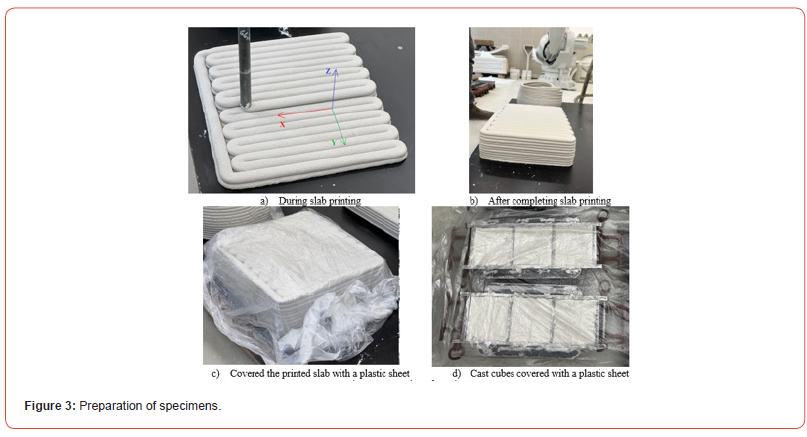
Additionally, a total of eighteen cast cubes, comprising six cubes for each mixture with dimensions of 100 mm, were prepared. These specimens underwent compaction utilising a vibrating table, adhering to the specifications outlined in EN 12390-2:2009 [26]. Post-casting, the top surface of these cubes was shielded with a plastic sheet to prevent undue water evaporation. After a 24- hour period, the cubes were de-moulded, stored under ambient temperature conditions, and subjected to testing after 28 days.
Compressive Strength Test

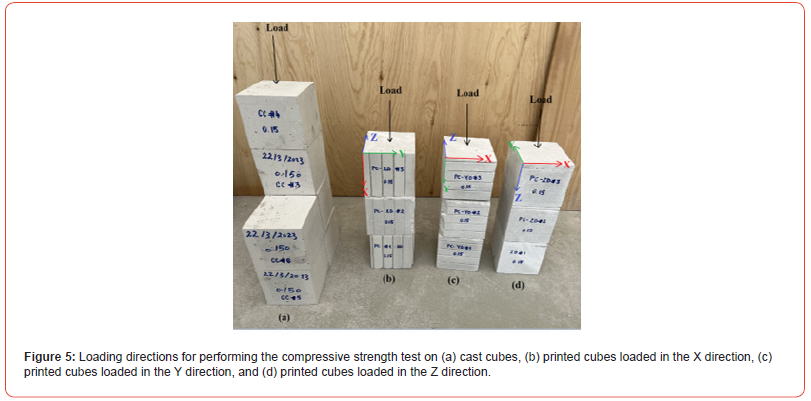
The printed cubes, with dimensions 100 × 100 × 100 mm, were sawn from the printed slab, (see Figure 4). The printed cubes were tested in X, Y, and Z directions (see Figure 5), and the average value was calculated through three repeated tests in each direction. Thus, for each mix, nine printed cubes were prepared and tested in total. Moreover, a total of six cast cubes were prepared for each mix for comparison purposes. The compressive strength of cast and printed cubes was determined by using a compression testing machine with a loading capacity of 3000 kN at a load rate of 5 kN/s. The compression test was conducted following the specifications of European Standard EN 12390-4:2009 [27]. The compressive strength test was carried out for all cast and printed samples at the age of 28 days.
Test Results and Discussion
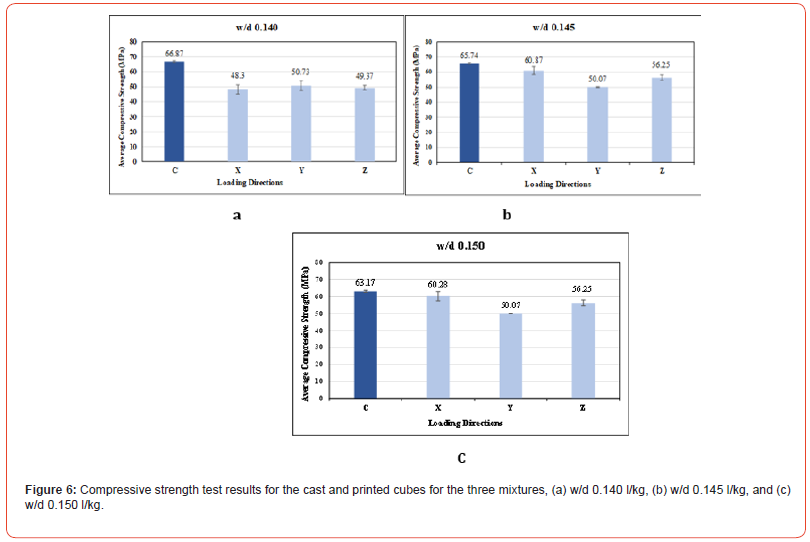
The results of the compressive strength of the cast and printed cubes at 28 days are presented in Table 1. Figure 6. Shows the average cast and printed compressive strength for the three mixes. According to the test results, the cast concrete has a higher compressive strength than the printed concrete. Similar compressive strength results were reported [19,20,28,29]. An anisotropic behaviour was observed in the compressive strength of the printed cubes, depending on the loading direction. The distinct mechanical anisotropy of printed samples might be due to the weak interface and the printing quality. Besides, Nerella et al. [14], identified that the compaction due to the layer weight should also be taken into consideration for the variation of compressive strength.
Table 1:Compressive strength results of cast and printed cubes at 28 days.
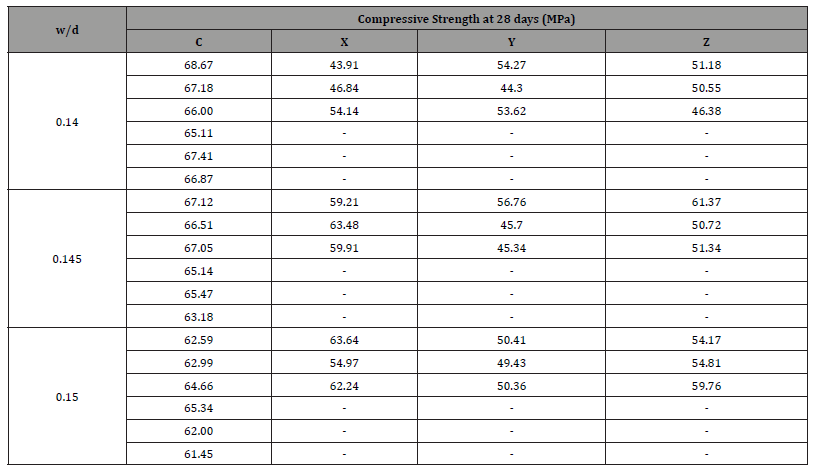
The mixtures with water ratios of 0.145 l/kg and 0.150 l/ kg were stronger in the loading direction X compared to Z and Y directions. Similar anisotropic behaviour was reported by [11,30,31]. The application of pressure during the extrusion process plays a pivotal role in enhancing the compaction of the mixtures along the X direction. Conversely, the mean compressive strength in the Y direction is observed to be the lowest due to the material’s unrestrained expansion and settling in this orientation. Notably, the absence of external pressure in the lateral direction results in comparatively weaker compaction than in the X and Z directions. In the latter, where compaction is intermediate, pressure is exerted by the weight of the subsequently printed layer above, contributing to a balanced compressive strength between the X and Y directions. While the mix with water ratio 0.140 l/kg shows different anisotropic behaviour, the loading direction Y was the strongest compared to X and Z directions, similar results were obtained by [18-20].
Loading Direction Effect
Mixtures 0.145 l/kg showed the best compressive strength at 28 days in three different directions, compared with mixtures 0.150 l/kg and 0.140 l/kg, (see Figure 6-b). The average compressive strength in the loading direction X was higher than the average compressive strength in the Y and Z directions by about 17% and 7%, respectively. Meanwhile, mixture 0.150 l/kg showed close results to mixture 0.145 l/kg (see Figure 6-c). The average compressive strength in the loading direction X was higher by about 19% and 10% than the loading directions Y and Z, respectively.
However, the mixture, 0.140 l/kg, showed the lowest compressive strength for printed cubes and the highest for cast ones (see Figure 6a). The lower water content changed the anisotropic behaviour of the printed cubes. The loading direction Y showed the highest compressive strength by about 5% and 3% more than the compressive strength in the loading directions X and Z, respectively.
Water Content Effect
Generally, the compressive strength tends to decrease as the water-to-material ratio increases. This is consistent with conventional concrete behaviour, where an excess of water can lead to a weaker structure, as shown in Figure 7. However, for printing concrete, the compressive strength tends to increase as the water to-material ratio increases. Maintaining an optimal water content is critical for achieving favourable pumpability, printability, and interlayer bonds in 3D concrete printing. Optimal water content is crucial for maintaining the desired viscosity and flowability of the mixture. Excessive water can lead to segregation, reduced viscosity, increased susceptibility to clogging in the pumping system, and can lead to excessive flow and slump, compromising the printed structure’s dimensional accuracy. Conversely, insufficient water content may result in a mix that is too stiff to be effectively pumped. Moreover, printing stiff concrete will reduce the bonding between the layers, affecting the overall characteristics of the printed element. However, the orthotropic behaviour of 3D printed concrete can be minimized by selecting the proper materials and mix design, using the correct nozzle speed, pumping rate, nozzle shape and reducing the gap time between the layers.
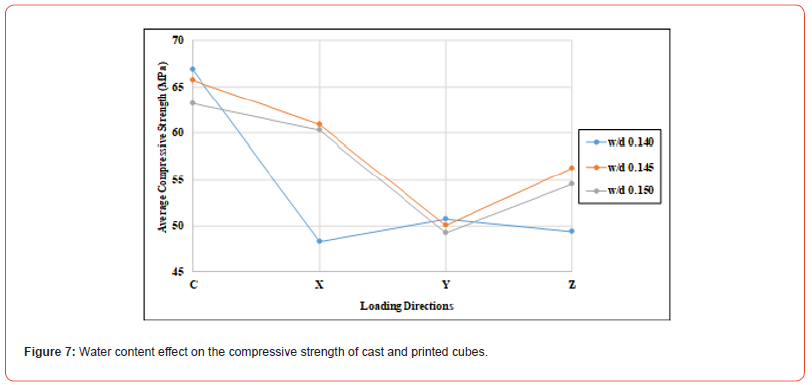
Conclusion
We have made significant progress in utilizing robotic systems for concrete printing, a technology that enables precise handling and placement of concrete materials. However, the effectiveness of this robotic application hinges on its compatibility with the rheology properties of concrete, which undergo continuous changes. Therefore, it is essential to deploy the robot in a manner that aligns with the evolving nature of concrete. When considering the attributes of the robot, we must carefully select parameters that are suitable for accommodating the variability inherent in concrete materials, such as pumping rate, printing speed, nozzle standoff distance, and nozzle diameter.
In conclusion, the investigation into the compressive strength
of 3D printed (tested in three different direction X, Y, and Z), and
cast concrete cubes, utilising three distinct water-to-dry material
ratios (0.140 l/kg, 0.145 l/kg, and 0.150 l/kg) and tested at 28 days,
yields insightful findings regarding the impact of water content and
printing directions on the structural performance. The following
key observations can be drawn:
1) Loading Direction Effects:
a) The orientation of printing has a significant effect on
compressive strength.
b) Mixture 0.145 l/kg showed the highest compressive
strength in all three directions.
c) The loading direction in X consistently exhibits the
highest compressive strength for printed cubes for the mixture
0.145 and 0.150, indicating a favourable layering or deposition
pattern in this direction. While for the stiff mixture 0.140, the X
direction showed the lowest compressive strength.
d) The Y and Z directions generally show lower compressive
strengths than the X direction, highlighting the importance of
considering the printing direction’s influence on structural
performance.
2) Water Content Influence:
a) As the water-to-material ratio increases, a consistent
reduction in compressive strength is observed for the cast
cubes. However, the opposite effect for the 3D printed cubes.
b) The 0.140 l/kg water-to-material ratio yields the highest
compressive strength for cast cubes but the lowest for 3D
printed cubes, emphasising the impact of the printing process
on material behaviour.
3) Optimisation Considerations:
a) The findings underscore the importance of optimising
water-to-material ratios and printing directions to achieve
desired compressive strength in 3D printed concrete structures.
b) Further research and refinement of printing parameters
are warranted to balance pumpability, printability, and
structural performance.
Acknowledgement
The Stipendium Hungaricum Scholarship Program is highly acknowledged for supporting PhD study and research work. Authors acknowledge the support by the Hungarian Research Grant VKE 2018-1-3-1_0003 “Development of advanced concrete elements”. Thanks to Anna Szijártó, Balázs Burai, and Izabella Kovacs as well as Dr. Sándor Sólyom for their help in the printing process and the laboratory measurements.
Conflict of Interest
None.
References
- J Schwartz (2018) Graphic statics and their potential for digital design and fabrication with concrete, Cement and concrete research 112: 122-135.
- A Paolini, S Kollmannsberger E Rank (2019) Additive manufacturing in construction: A review on processes, applications, and digital planning methods, Additive manufacturing 30: 100894.
- RA Buswell, WL De Silva, SZ Jones, J Dirrenberger (2018) 3D printing using concrete extrusion: A roadmap for research, Cement and Concrete Research 112: 37-49.
- Y Chen, S He, Y Gan, O Çopuroğlu, F Veer, et al. (2022) A review of printing strategies, sustainable cementitious materials and characterization methods in the context of extrusion-based 3D concrete printing. Journal of Building Engineering 45: 103599.
- SC Figueiredo, Claudia Romero Rodriguez, Zeeshan Ahmed, DH Bos, et al., (2019) An approach to develop printable strain hardening cementitious composites, Materials & Design 169: 107651.
- V Nerella, M Näther, A Iqbal, M Butler, V Mechtcherine (2019) Inline quantification of extrudability of cementitious materials for digital construction, Cement and Concrete Composites 95: 260-270.
- A Al Rashid, SA Khan, SG Al-Ghamdi, M Koç (2020) Additive manufacturing: Technology, applications, markets, and opportunities for the built environment, Automation in Construction 118: 103268.
- C Menna, Jaime Mata-Falcón, Freek P. Bos, Gieljan Vantyghem, Liberato Ferrara, et al., (2020) Opportunities and challenges for structural engineering of digitally fabricated concrete. Cement and Concrete Research 133: 106079.
- TT Le, SA Austin, S Lim, RA Buswell, AG Gibb, et al. (2012) Mix design and fresh properties for high-performance printing concrete, Materials and structures 45: 1221-1232.
- J Zhang, J Wang, S Dong, X Yu, B Han (2019) A review of the current progress and application of 3D printed concrete, Composites Part A: Applied Science and Manufacturing 125: 105533.
- AR Arunothayan, B Nematollahi, R Ranade, SH Bong, JG Sanjayan, et al. (2021) Fiber orientation effects on ultra-high-performance concrete formed by 3D printing, Cement and Concrete Research 143: 106384.
- NS Alimrani, MM Thajeel, LG Balázs (2022) Structural Aspects of Topology Optimization in 3D Printing of Concrete, concrete structures: Journal of the Hungarian group of FIB 23: 41-46.
- G De Schutter, K Lesage, V Mechtcherine, VN Nerella, G Habert, et al. (2018) Vision of 3D printing with concrete-Technical, economic and environmental potentials, Cement and Concrete Research 112: 25-36.
- VN Nerella, S Hempel, V Mechtcherine (2019) Effects of layer-interface properties on mechanical performance of concrete elements produced by extrusion-based 3D-printing, Construction and Building Materials 205: 586-601.
- R Wolfs, F Bos, T Salet (2019) Hardened properties of 3D printed concrete: The influence of process parameters on interlayer adhesion, Cement and Concrete Research 119: 32-140.
- B Panda, SC Paul, NAN Mohamed, YWD Tay, MJ Tan (2018) Measurement of tensile bond strength of 3D printed geopolymer mortar, Measurement 113: 108-116.
- YWD Tay, GHA Ting, Y Qian, B Panda, L He, et al. (2019) Time gap effect on bond strength of 3D-printed concrete, Virtual and Physical Prototyping 14(1):104-113.
- Y Chen, Erik Schlangen, Yidong Gan, Koen Jansen, Hongzhi Zhang, et al., (2020) Effect of printing parameters on interlayer bond strength of 3D printed limestone-calcined clay-based cementitious materials: An experimental and numerical study, Construction and Building Materials 262: 120094.
- B Panda, GB Singh, C Unluer, MJ Tan (2019) Synthesis and characterization of one-part geopolymers for extrusion-based 3D concrete printing, Journal of cleaner production 220: 610-619.
- Y Chen et al., (2020) Improving printability of limestone-calcined clay-based cementitious materials by using viscosity-modifying admixture, Cement and Concrete Research 132: 106040.
- Y Chen, S He, Y Zhang, Z Wan, O Çopuroğlu, et al. (2021) 3D printing of calcined clay-limestone-based cementitious materials, Cement and Concrete Research 149: 106553.
- B Panda, S Ruan, C Unluer, MJ Tan (2019) Improving the 3D printability of high-volume fly ash mixtures via the use of nano attapulgite clay, Composites Part B: Engineering 165: 75-83.
- Y Zhang, Y Zhang, W She, L Yang, G Liu, et al. (2019) Rheological and harden properties of the high-thixotropy 3D printing concrete, Construction and Building Materials 201: 278-285.
- Y Zhang, Y Zhang, G Liu, Y Yang, M Wu, et al. (2018) Fresh properties of a novel 3D printing concrete ink, Construction and building materials 174: 263-271.
- (2023) Available online: www.sika.com (accessed 10-29).
- EN12390-2:2009. Testing hardened concrete - Part 2: Making and curing specimens for strength tests.
- EN12390-3:2009. Testing hardened concrete - Part 3: Compressive strength of test specimens.
- B Panda, SC Paul, LJ Hui, YWD Tay, MJ Tan (2017) Additive manufacturing of geopolymer for sustainable built environment, Journal of cleaner production 167: 281-288.
- TT Le et al., (2012) Hardened properties of high-performance printing concrete, Cement and Concrete Research 42(3): 558-566.
- B Nematollahi, M Xia, SH Bong, J Sanjayan (2019) Hardened properties of 3D printable ‘one-part’ geopolymer for construction applications, in First RILEM International Conference on Concrete and Digital Fabrication-Digital Concrete 2018, Springer, 190-199.
- JG Sanjayan, B Nematollahi, M Xia, T Marchment (2018) Effect of surface moisture on inter-layer strength of 3D printed concrete, Construction and building materials 172: 468-475.
-
György L Balázs* and Marwah M Thajeel. 3D Concrete Printing with Robot - Resulted Properties. On Journ of Robotics & Autom. 2(3): 2024. OJRAT.MS.ID.000540.
3D concrete printing; Additive Manufacturing; Layer-by-layer, Orthotropy, Structural integrity, Water content; Loading directions; Compressive strength
-

This work is licensed under a Creative Commons Attribution-NonCommercial 4.0 International License.






